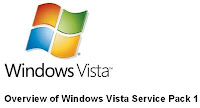 With the first release candidate of Windows Vista SP1 just a few days away, Microsoft is now finally opening up and revealing what can be expected in the first service pack to Microsoft’s flagship operating system, Windows Vista.
With the first release candidate of Windows Vista SP1 just a few days away, Microsoft is now finally opening up and revealing what can be expected in the first service pack to Microsoft’s flagship operating system, Windows Vista. Simply put, Windows Vista SP1 will add tons of added hardware compatibility, loads of compatibility, better system reliability, and Ofcourse better performance and better energy saving for laptops etc.. The standalone installer will come in at about 450MB, but if you were to download Service Pack 1 through Windows Update, it would take only about 65MB. The reason is quite obvious enough, you might have already downloaded many of the hotfixes, security updates and other features that are included in Service Pack 1.
Well here are the few features in SP1 that make me get really excited, and should probably get you excited too…
- Adds support for Direct3D® 10.1, an update to Direct3D 10 that extends the API to support new hardware features.
- SP1 addresses issues many of the most common causes of crashes and hangs in Windows Vista, as reported by Windows Error Reporting. These include issues relating to Windows Calendar, Windows Media Player, and a number of drivers included with Windows Vista.
- Adds support for exFAT, a new file system supporting larger overall capacity and larger files, which will be used in Flash memory storage and consumer devices.
- Enhances support for high density drives by adding new icons and labels that will identify HD-DVD and Blu-ray Drives as high density drives.
- Improves power consumption and battery life.
- Improves the speed of adding and extracting files to and from a compressed (zipped) folder.
- Improves the speed of copying files, folders, and other media.
- Improves startup and resume times when using ReadyBoost.
- Users can control which volumes the disk defragmenter runs on.




